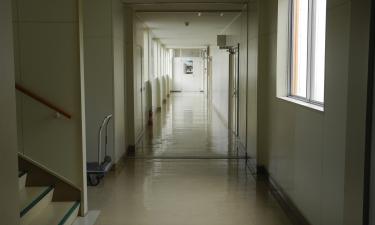Blind people cannot afford to have seeing eye dogs in Russia
Getting a guide-dog in Russia is as difficult as adopting a baby
People know many legends and incredible stories about guide-dogs. In Australia, one sheep dog saved the lives of a blind woman and her three children when it warned them of a fire that broke out in the middle of the night. People also say that a guide-dog led its blind master out of the 70th storey of the WTC on the day of the 9/11 tragedy in New York. Another dog sacrificed its life to save its master from a traffic accident. 
In Russia, the Republican School for Recovery of working abilities of blind people and training of guide-dogs in Kupavna, the Moscow Region, is the only place in this country where guide-dogs are trained.
On the training ground of the school all objects and obstacles resemble the real life so that guide-dogs could know how to behave in every particular situation starting with the very first day of training. Dog trainers use a walking stick and a breast-band so that guide-dogs could get used to the mode of living of their future blind masters. If a guide-dog sees an obstacle over three centimeters high and can walk around the obstacle it must do it. In case it does not it must stop for some time so that its blind master could touch a safe way with a walking stick and tell the dog to continue walking.
Click here to see the photo gallery of Russian army dogs
Besides helping blind people reach some place guide-dogs must also watch that their masters do not stumble, run against something or fall down. These dogs help their blind masters cross highways and tram-lines, walk around benches and borders; they also help people get into public transport. Dog trainers say that when a guide-dog follows an unknown route the animal is not supposed to deviate from the straight road and make no turns without any command from the master. Such dogs must be incredibly patient and enduring.
It is known that dogs cannot discern colors and thus they do not see the colors of traffic lights. But a guide-dog will never let the master walk in case a car is too close.
Dogs enjoy really good lives at the Republican School for Training Guide-Dogs: they are fed with high quality expensive dog food. Food and maintenance costs about $300 a month there, a really high sum even for common Russians.
The training process is sometimes very hard for dogs but thanks to intensive working guide-dogs perform automatically. Like any other dog, guide-dogs need human care, daily walks, games and love.
Getting a guide-dog in Russia is as difficult as adopting a baby. A dog trainer at the above-mentioned school says that some people have been on a waiting list for getting a dog since 2000.
When dogs arrives at the training school (the school presumably trains Labradors and sheep dogs), it first of all gets sterilized and gelded to destroy the sex instinct that may frustrate the training process. It takes about six monthsin generalto train a guide-dog. First goes general training which is applied to all types of dogs not only guide-dogs. Then there is a special training for guide-dogs that must be performed in presence of the dog's future master so that both could get used to each other and the dog could know all habits of its master. It is important for dog trainers not only to train guide-dogs but also help masters and dogs establish close contacts. Blind people come to the Republican School for Training Guide-Dogs from various parts of the country. Unfortunately, today not every blind man can afford a guide-dog: dog food costs over $30 a month and another $25 must be paid for vaccinations every year.
Dog trainers say they seldom train mongrels because blind people usually prefer having sheep dogs and Labradors. The school would have trained all mongrels from dog shelters of the Moscow Region if the dog breed were of no importance for those who come to the school to take guide-dogs. It is important that dog trainers will never work with severe and fearful dogs with unstable psyche.
Clever guide-dogs remember up to 40 routes that their blind masters regularly follow and may lead the masters there just upon one command word.
A blind woman named Lyudmila came to the school for training guide-dogs to have a close friend and a devoted aid in her everyday life. Without a guide-dog the woman has to stay at home all the day long but she needs to go out and have walks. The woman lost her eyesight many years ago in an accident: some man assaulted her in the street, hit her in the face and seized her fur cap. When Lyudmila realized that she could not see she even wanted to commit suicide as she could not imagine how to continue living and be unable to see the world around her. Doctors persuaded her to give up her suicide ideas for the sake of her six children. Indeed, that was a really brave doing for the woman as she was 35 at that time. Now she has a guide-dog Lora. The woman says they both fell in love with each other as soon as they met. She adds they are both very optimistic. The dog feels that it is really wanted and hopes that her new life with the blind master will be happy.
A guide-dog means not only rehabilitation for blind people; like any other human being a blind man also wants to have a lovingand loved creature by his side. It is important for those who cannot see the world to touch and caress a dog and feel love and protection from the dog in response.
Humans originally began training guide-dogs began in Vienna in 1819. Systematic training was launched in Germany after WWI. In Russia, professional training of guide-dogs was started after WWII. Today, the training school in Kupavna is Russia's only organization that trains Seeing Eye dogs for the blind. Unfortunately it cannot satisfy the entire demand for guide-dogs in such a huge country as Russia.
Discuss this article on Pravda.Ru ENGLISH FORUM
Subscribe to Pravda.Ru Telegram channel, Facebook, RSS!




